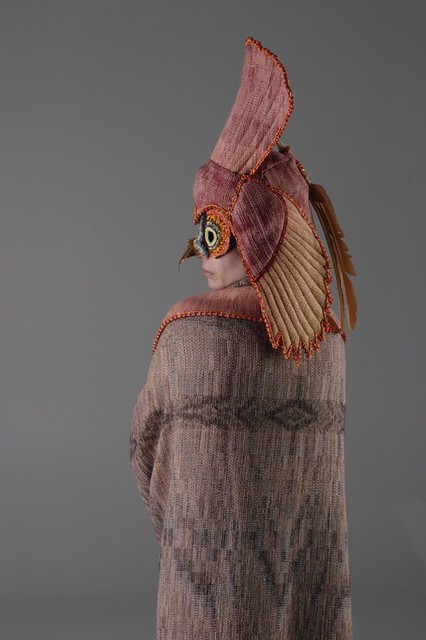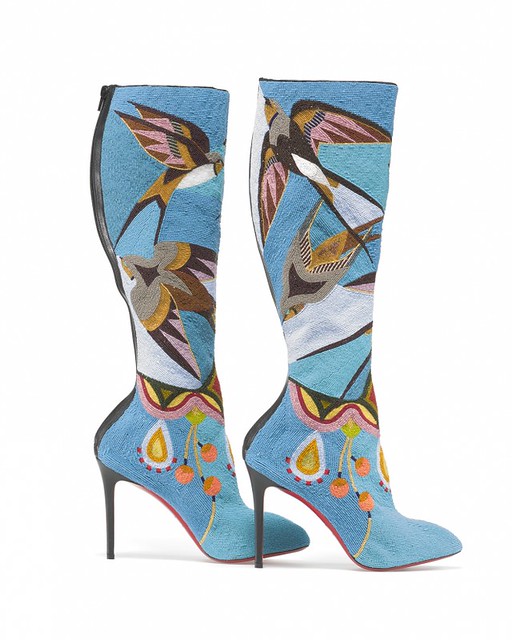The Smithsonian’s National Museum of the American Indian’s George Gustav Heye Center in New York will host the final showing of the first large-scale traveling exhibition of contemporary Native American fashion, celebrating indigenous designers from across the United States and Canada, from the 1950s to today. “Native Fashion Now,” originally organized by the Peabody Essex Museum in Salem, Mass., explores the exciting and complex realms where fashion meets art, cultural identity, politics and commerce.
The exhibition opens Friday, Feb. 17, 2017, in the museum’s East Gallery and runs through Sept. 4. Learn more: http://www.si.edu/Exhibitions/Details/Native-Fashion-Now-6023
Through nearly 70 works, “Native Fashion Now” explores the vitality of Native fashion designers and artists—from pioneering Native style-makers of the mid-20th century like Charles Loloma (Hopi Pueblo) to maverick designers of today such as Wendy Red Star (Apsálooke [Crow]). The exhibition immerses visitors in all aspects of contemporary Native fashion—its concerns, modes of expression and efforts to create meaning through fashion. “Native Fashion Now” is the first show to emphasize the long-standing, evolving and increasingly prominent relationship between fashion and creativity in Native culture.
“New York City is a fashion capital of the world and the works shown in this exhibition belong on this stage,” said Kevin Gover (Pawnee), director of the National Museum of the American Indian. “Native voice is powerful and Native couture is a megaphone. These designers’ works demonstrate to visitors the contemporary strength of Native iconographies and sensibilities.”

Margaret Roach Wheeler (Chickasaw) for Mahota Handwovens, The Messenger (The Owl) cape and headpiece, from the Mahotan Collection, 2014. Silk-wool yarn; silk-wool yarn, metal, silver, glass beads, and peacock feathers. Courtesy of the designer. Photo by Greg Hall.
The exhibition's four themes—Pathbreakers, Revisitors, Activators and Provocateurs—reflect how designers respond to ideas and trends in the world of Native fashion. Pathbreakers are groundbreaking designers like Dorothy Grant (Haida) and Frankie Welch (Cherokee descent), while Revisitors refresh, renew and expand on tradition, like D.Y. Begay (Diné [Navajo]) and Bethany Yellowtail (Apsáalooke/Northern Cheyenne). Activators embrace an everyday, personal style that engages with today’s trends and politics, like the work of Marcus Amerman (Choctaw) that considers the overlap between mainstream and Native culture in America, while Provocateurs, like Margaret Roach Wheeler (Chickasaw) and Sho Sho Esquiro (Kaska Dene/Cree), depart from conventional fashion to make works that are conceptually driven and experimental.
Among the dozens of notable designers included in “Native Fashion Now” are Lloyd “Kiva” New (Cherokee), the first Native designer to create a successful high-fashion brand; Virgil Ortiz (Cochiti Pueblo), who in 2003 worked with fashion icon Donna Karan to create a bold collaborative couture collection and went on to launch his own fashion line, VO; Patricia Michaels (Taos Pueblo), who is known for her role on the popular show Project Runway and for her fashion line, PM Waterlily; and Jared Yazzie (Diné [Navajo]), an activist designer who uses streetwear to encourage people to think about the truths of history. For a full list of artists, see below.
![Jared Yazzie (Diné [Navajo]) for OxDx, Native Americans Discovered Columbus t-shirt, 2012. The Smithsonian’s National Museum of the American Indian's Native Fashion Now Exhibit. Photo by Thosh Collins.](https://c1.staticflickr.com/3/2388/32807111905_04a42377c5_z.jpg)
Jared Yazzie (Diné [Navajo]) for OxDx, Native Americans Discovered Columbus t-shirt, 2012. Cotton. Gift of Karen Kramer. Peabody Essex Museum, 2015.11.4. Photo by Thosh Collins.
All of the designers express their artistic agency, cultural identity, and their unique personal perspective. “Native Fashion Now” is a dynamic, contemporary fashion scene that showcases both roots and cutting-edge, new paths. Runway footage, artist interviews and fashion photography communicate its immediacy throughout the exhibition.
“Native American art and culture are often perceived as phenomena of the past—or just mere replicas,” said Karen Kramer, Peabody Essex Museum curator of Native American and Oceanic art and culture, including the “Native Fashion Now” exhibition. “But that couldn’t be further from the truth. Contemporary Native fashion designers are dismantling and upending familiar motifs, adopting new forms of expression and materials, and sharing their vision of Native culture and design with a global audience.”

Jamie Okuma (Luiseño and Shoshone-Bannock), boots, 2013–14. Glass beads on boots designed by Christian Louboutin. Museum commission with support from Katrina Carye, John Curuby, Karen Keane and Dan Elias, Cynthia Gardner, Merry Glosband, and Steve and Ellen Hoffman. Peabody Essex Museum, 2014.44.1AB. Copyright 2015 Peabody Essex Museum. Photo by Walter Silver.
Public Reception
An opening reception is scheduled for Thursday, Feb. 16, 2017, at 6 p.m. featuring a “Curator’s Conversation” with Kramer and Kathleen Ash-Milby (Diné [Navajo]), associate curator at the National Museum of the American Indian. Admission is free.
Symposium
A symposium, “Native/American Fashion: Inspiration, Appropriation and Cultural Identity,” held in conjunction with the “Native Fashion Now” exhibition, will bring together Native and non-Native historians, fashion designers and artists working in the fields of fashion, law and indigenous studies. The expert speakers will address fashion as a creative endeavor and an expression of cultural identity, issues of problematic cultural appropriation in the field and examples of creative collaborations and best practices between Native designers and fashion brands. The symposium is co-sponsored with the Fashion Institute of Technology, State University of New York and takes place Saturday, April 22, 2017, from 10:30 a.m. to 5 p.m. Admission is free.
As lead organizer of the exhibition, the Peabody Essex Museum hosted “Native Fashion Now” from Nov. 21, 2015, through March 6. The exhibition then traveled to the Portland Art Museum in Portland, Ore., and the Philbrook Museum of Art in Tulsa, Okla., before its final destination at the Smithsonian’s National Museum of the American Indian in New York.
The Coby Foundation Ltd. provided support for “Native Fashion Now.” Funding for the New York presentation of this exhibition and associated programming is made possible through the support of Ameriprise Financial. Additional funding provided by Macy's.
About the National Museum of the American Indian
The National Museum of the American Indian, George Gustav Heye Center is located in the Alexander Hamilton U.S. Custom House at One Bowling Green in New York City. For additional information, including hours and directions, visit AmericanIndian.si.edu. Follow the museum via social media on Facebook, Twitter and Instagram. Join the conversation using #NativeFashionNow.
Artists/designers represented:
Gabriel Mozart Abeyta (Taos Pueblo)
Barry Ace (Anishinaabe [Odawa])
Ray Adakai (Diné)
Pilar Agoyo (Ohkay Owingeh [San Juan]/Cochiti/Kewa [Santo Domingo] Pueblos)
Marcus Amerman (Choctaw)
Jeremy Arviso (Diné/Hopi/Pima/Tohono O’odham)
Keri Ataumbi (Kiowa)
D.Y. Begay (Diné)
Eddie Begay (Diné)
MaRia A. Bird (Diné/Hopi/Santa Clara Pueblo)
Mike Bird-Romero (Ohkay Owingeh [San Juan]/Taos Pueblos)
Caroline Blechert (Inuit)
Dustinn Craig (White Mountain Apache/Diné)
Kristen Dorsey (Chickasaw)
Orlando Dugi (Diné)
Alano Edzerza (Tahltan)
Sho Sho Esquiro (Kaska Dene/Cree)
Nicholas Galanin (Tlingit/Aleut)
David Gaussoin (Diné/Picuris Pueblo)
Wayne Nez Gaussoin (Diné/Picuris Pueblo)
Louie Gong (Nooksack/Squamish)
Dorothy Grant (Haida)
Teri Greeves (Kiowa)
Thomas Haukaas (Sicangu Lakota)
Carla Hemlock (Mohawk)
Terrance Houle (Blood)
Derek Jagodzinsky (Whitefish Cree)
Elizabeth James-Perry (Aquinnah Wampanoag)
Tommy Joseph (Tlingit)
Donna Karan
Juanita Lee (Kewa [Santo Domingo] Pueblo)
Charles Loloma (Hopi Pueblo)
Dustin Martin (Diné)
Dallin Maybee (Northern Arapaho/Seneca)
Patricia Michaels (Taos Pueblo)
Douglas Miles (San Carlos Apache/Akimel O’odham)
Kent Monkman (Cree)
Lloyd “Kiva” New (Cherokee)
Winifred Nungak (Inuit)
Jamie Okuma (Luiseño/Shoshone-Bannock)
Virgil Ortiz (Cochiti Pueblo)
Consuelo Pascal (Diné/Maya)
Niio Perkins (Akwesasne Mohawk)
Jonathan Perry (Aquinnah Wampanoag)
Wendy Ponca (Osage)
Kevin Pourier (Oglala Lakota)
Pat Pruitt (Laguna Pueblo)
Wendy Red Star (Apsáalooke [Crow])
Maria Samora (Taos Pueblo)
Cody Sanderson (Diné/Hopi/Tohono O’odham/Nambé Pueblo)
Alice Shay (Diné)
Troy Sice (Zuni Pueblo)
Maya Stewart (Chickasaw/Creek/Choctaw descent)
Lisa Telford (Haida)
Denise Wallace (Chugach Aleut)
Samuel Wallace
Robin Waynee (Saginaw Chippewa)
Frankie Welch (Cherokee descent)
Margaret Roach Wheeler (Chickasaw)
Dwayne Wilcox (Oglala Lakota)
Kenneth Williams Jr. (Northern Arapaho/Seneca)
Toni Williams (Northern Arapaho)
Margaret Wood (Diné/Seminole)
Rico Lanaat’ Worl (Tlingit/Athabascan)
Jared Yazzie (Diné)
Jolene Nenibah Yazzie (Diné)
Bethany Yellowtail (Apsáalooke [Crow]/Northern Cheyenne)
All information and photos contained herein courtesy and copyright Smithsonian
